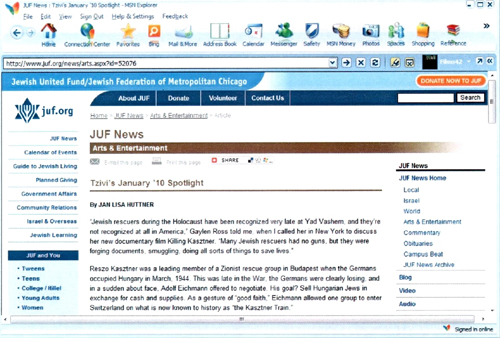
Click HERE to read Jan’s feature on
KILLING KASZTNER
in the January issue of Chicago’s JUF
NEWS.
Click HERE to download Jan’s January ’10 column as a
pdf.
Click HERE to see photos from filmmaker Gaylen Ross’ trip to Chicago.
|
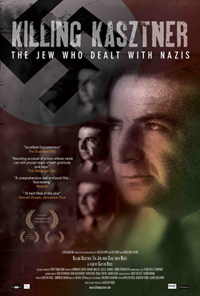
|
Filmmaker
Gaylen Ross
Discusses
Her Controversial New Doc
Killing Kasztner
Click HERE to download this interview as a pdf file.
|
Reszo Kasztner was a leading member of a Zionist rescue group in Budapest when the Germans occupied Hungary in March, 1944. This was late in the War, the Germans were clearly losing, and in a sudden about face, Adolph Eichmann offered to negotiate. His goal? Sell Hungarian Jews in exchange for cash and supplies. As a gesture of “good faith,” Eichmann allowed one group to enter Switzerland on what is now known to history as “the Kasztner Train.”
After the war, Kasztner made aliyah, but once in Israel, he was condemned as a collaborator. Yes, it’s about the Holocaust, but
KILLING KASZTNER also addresses urgent issues equally relevant in our own era.
Jan called Gaylen to discuss her film prior to its Chicago premiere at the Music Box Theatre on January 8, 2010.
*****
Jan: When did you first become interested in this subject, Gaylen?
Gaylen: Around 1997; I was producing and writing a documentary on Swiss banks and Holocaust accounts (BLOOD MONEY: SWITZERLAND’S NAZI GOLD), and there was a woman, Alice Fisher, who got to Switzerland, she said, “on the Kasztner Train.” I didn't know what she was talking about. I said: "What is this train, and who was Kasztner?"
And I thought: “This is incredible!” I'd heard about non-Jews who rescued Jews (like Schindler and Wallenberg) and all the smaller but equally courageous stories (hiding Jews in barns and in attics,) but the idea that there was a Jew who rescued thousands of Jews during the War, and it’s not even a conversation, was amazing to me.
I didn't know enough to say: "Is this man a hero or not a hero?" I didn't even understand the level of complexity and controversy, which I soon found out, about this story. But I just thought: “How is this not even discussed? How is this not in our books? Why are we not shouting it from the rooftops?”
There was this Jew, Rezso Kasztner, who negotiated for thousands. And the fact that he was erased from our Holocaust teachings was incredible to me. That's when I started researching, and those who did know some of the story said: “Don't do this. Don't go there. It's too controversial. It's too difficult."
And then they said: "Well, if you're going to do it, talk to Professor Egon Mayer." He has since passed away, but he worked with me on the film. His mother was pregnant with him on the Kasztner train. He was a professor. His specialty was sociology, not history, but as his avocation, he was the one in the U.S. who became the keeper of the flame.
And Mayer was approached to moderate a symposium at the Museum of Jewish Heritage in Manhattan. That was June ’01, right before the World Trade Center …
We filmed, and that was the first and only symposium on Kasztner in America.
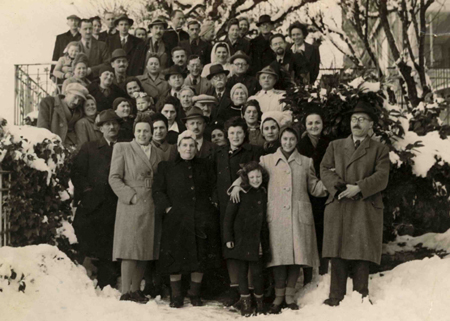
Kasztner Train Survivors in Switzerland
Jan:
This is really helpful background, Gaylen, because watching KILLING KASZTNER
the first time, I was amazed by the amount of access you had, especially at Yad Vashem. I was frankly stunned that you were allowed to film real-time conversations between Yad Vashem officials and Kasztner Train survivors.
Gaylen:
The survivors had wanted to have a meeting about Kasztner with the head of Yad Vashem for a long time—to discover where Kasztner existed in the institution’s understanding of rescue, and how he was to be acknowledged, or at least mentioned.
I went to Yad Vashem with the survivors and we filmed the meeting. I don't speak Hebrew, but, as opposed to other situations, the survivors weren't going to wait for me and conduct their meeting in English. This is much too important for them. So they went ahead in Hebrew, and I had no idea what they were saying until the meeting was over and I went back to New York and got it translated.
And I have to hand my hat to Avner Shalev, the Director of Yad Vashem, who was in a very, very sensitive, difficult situation. With survivors confronting him, he allowed the filming to go on. He allowed himself to be presented in this difficult situation, and following that meeting, Yad Vashem has been amazing in addressing Kasztner and acknowledging him—not just the receipt of the Kasztner archives in ’07, but a special presentation on Holocaust Memorial Day of the film
KILLING KASZTNER just last April (’09) in the Jerusalem Center for Performing Arts, introduced by the Mayor of Jerusalem.
This was a huge gesture and very courageous, and they received criticism from those still against Kasztner for presenting the film on this most important day in Israel, but they proceeded anyway. Israeli television also chose to broadcast the film on the eve of Yom HaShoah, so it was a very significant step forward for the re-examination of Kasztner.
Jan:
So Israelis are intellectually vigorous on this subject?
Gaylen:
Yes, the Israelis are ahead on this; they're not afraid to look at it. But of course it is also their story—the political and historical background of the nation. The trial and the assassination of Kasztner was a monumental period in their country’s past.
However, I wish American institutions here would be so forthcoming, for it is also an important story for all Jewish communities, in Israel and abroad. I’m pleased to say that The Museum of Jewish Heritage in Manhattan (where we originally filmed in ’01), is going to present the film on March 7th, near the date of the German occupation of Hungary. And I would like to see other Jewish American institutions start talking about Kasztner, whether they show the film or not.
Jan:
How do you answer the charge that you're “an apologist” for Kasztner?
Gaylen:
For every person, every reviewer, and every article that says my film is biased, there’s another one that says it’s not, so I don't consider the reviews anymore. What I try to do in my film is say: “Look, here's the new information.”
Some people are still reading Ben Hecht’s PERFIDY after five decades. I understand very, very well the argument that the right-wing had against Ben Gurion’s government. Unfortunately, the Kasztner trial became politicized—both the politicization of the Holocaust and the means to bring down the government (which was essentially Ben Gurion’s party) and to attack what was thought Ben Gurion’s inadequate rescue of Jews during the World War. Unfortunately Kasztner became collateral damage in the course of this trial.
Hecht was a friend and political ally of Shmuel Tamir. PERFIDY isn’t a biography of Kasztner. Perfidy was written by a very good screenwriter who was never a historian, never a scholar. If people are still reading Ben Hecht and looking at my film and saying, “Ross is an apologist,” then it's like trying to explain the Kasztner story to somebody who’s only reading, I don't know what the equivalent would be—something as ridiculous as writers who still are purporting the world is flat.
Since Perfidy there are dozens of books written about this period of the Hungarian Holocaust, many by historians, and just these last two years two books on Kasztner.
(Editor’s Note: Gaylen is correct; a 1997 edition of Perfidy is still in print, and it’s available “new” from Amazon. Shmuel Tamir, long deceased, was opposing counsel in the Kasztner Trial. In
KILLING KASZTNER, Gaylen interviews his son.)
Jan:
So you’re saying you have no vested interest in any of this personally, right, no family members who were either on the Kasztner Train or not the Kasztner Train? Your starting point is the mystery of invisibility—why, even today, so many years later, is it still so hard to talk about Kasztner?
Gaylen:
I'm trying to separate the truth about Kasztner (and what Kasztner tried to do) from the rumors, falsehoods, misinformation, and politics. I was not there, but I've certainly read and looked at the newest research that has evolved over five decades. Archives have been opened, and new interpretations are now being given to the Hungarian Holocaust. This information was not available to Judge Benjamin Halevi during the original trial in Israel; not available to Ben Hecht; not available to the world then.
In Israel, unbelievably the first real national conversation about the Holocaust was during the Kasztner Trial (1953-1955), but it wasn’t until the Eichmann Trial (1961-1962) that people really started to understand the absolute isolation of Jews in Hungary—the speed of the ghettoization and deportation. The fact that people were doing anything at all to save any lives was an amazing thing. The blame, shame, and guilt that followed the Holocaust—much of it ended up at Israel’s doorstep. The bitter divide that happened in Israel politically is all part of this horrendous story, and the great tragedy, of course, that colors the entire Kasztner story is the Holocaust.
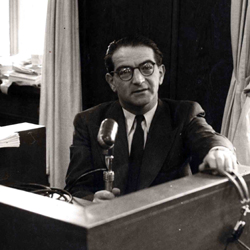
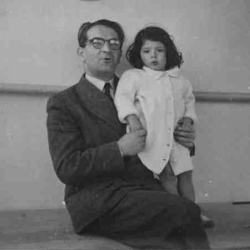
Rezso Kasztner with his daughter Zsuzsi
Jan:
From my POV, KILLING KASZTNER
is a fascinating film about the Holocaust, but even beyond that, I think you accomplish two things in this film that I’d like to discuss next.
First is the subject of negotiation. We sit here today at the tail end of 2009; World War II was a long time ago and tonight President Barack Obama is going to tell us his plan for Afghanistan. Negotiation is terribly, terribly difficult.
So it’s very easy to sit here in 2009 and say that Neville Chamberlain was an idiot, yak, yak, yak. But from the perspective of 1938, if the horrendous slaughter of World War I were fresh in our minds, we would say: “Please, Mr. Chamberlain, try anything! Negotiate with anybody if it will prevent a new war!” It’s only now, after the Holocaust, that appeasement looks like such a stupid strategy.
Applying that to Rezso Kasztner, shouldn’t we applaud that he negotiated as hard as he could, stalled for as long as he could, did whatever he could to keep murder at bay? Were you thinking about these broader questions?
Gaylen:
First of all, Kasztner’s negotiations in Hungary could not have happened at all and did not happen until the end of WWII, when the Germans were desperate, losing the war, and needing money and supplies. This was the initial basis for the negotiation: a million Jews for 10,000 trucks.
Jan:
Right, the Germans would not have been willing to negotiate before Stalingrad, when they still thought they were winning
…
Gaylen:
I think the idea of negotiation is an option, and it’s an option alongside other options. But what happens is that the negotiator ends up being the one that's condemned first—the one that’s maligned and looked at as weak.
Kasztner represents choices. In the section of
KILLING KASZTNER where we interview young students from Tel Aviv University, the students are looking at traditional hero models in Israel and saying: “We want other options.” It’s true that people do come to the conference table and conduct negotiations, but it’s often after much blood has already been shed in conflict and war. The option to talk with one’s enemies, to negotiate, shouldn’t mean it has to be the last resort.
Jan:
So one message of KILLING KASZTNER
is that we should always be vigilant in our negotiations, but still respect the negotiator?
Gaylen:
Exactly. In the early Israel, of course, that wasn’t even a consideration. As one of the older students at Tel Aviv University (actually a former paratrooper) says: “You can’t build a generation of soldiers on the legacy Kasztner, but you can build a generation of soldiers on the legacy of Hannah Senesh.”
Jan:
So, Hannah Senesh—Hannah Senesh was born in Hungary and made aliyah in 1939. She became a member of the Haganah, and then she enlisted in the British army and trained as a paratrooper so she could work with Hungarian partisans.
Gaylen:
Hannah Senesh was very courageous and she became the symbol of heroism in Israel. Her act of parachuting into Hungary in the midst of the Jewish deportations to Auschwitz resulted in her immediate capture, and she didn’t rescue anyone. But her willingness to sacrifice her life became the emblem, and that’s the difference. “Negotiator” has a certain taint to it, as if you're going to give away things—collaborate with your enemy, sacrifice some at the expense of others—as opposed to saving lives.
At the beginning of the film, I use a quote from Bertolt Brecht’s 1938 play Galileo:
“Unhappy is the land who has no heroes.”
“No, unhappy is the land who has a need for heroes.”
Kasztner thought of himself as a hero, but when we start naming some heroes at the expense of others—Hannah Senesh over Rezso Kasztner; the Warsaw Ghetto martyrs over those who negotiated—it seems so unfortunate and so sad.
And a big part of this is that Jewish rescue of Jews is not recognized at all; many Jewish rescuers had no guns, but were forging documents, smuggling, doing all sorts of things to save Jewish lives at even further risk to their own. It wasn’t just non-Jews who did this. Jewish rescuers have been recognized very late at Yad Vashem, and they’re still not recognized at all in America.
Jan:
So KILLING KASZTNER
reminds us there is also a kind of heroism—courage, faith, and an incredible amount of will—entailed in the role of negotiator?
Gaylen:
You’re absolutely right: at least let’s have the option, let’s have the possibility.
When we opened the film last January ’09, the Gaza War had just begun. I said to the Israeli producer: “Nobody’s going to come; who’s going to come to a film about a negotiator in the middle of a war?”
But the cinemas were absolutely packed, sold out, and the discussions after the film were incredibly profound, very emotional. People have many different feelings about Kasztner; pro and anti, but the fact that conversations were happening in the middle of the Gaza War was amazing to me.
Jan:
Okay, so subject number two: Let’s flip our conversation around from what
KILLING KASZTNER has to say about the role of negotiator, and let’s discuss what
KILLING KASZTNER has to say about the role of terrorist.
In Killing Kasztner, you have footage of Ze’ev Eckstein reflecting now on who Ze’ev Eckstein was at age 24 (when he shot Rezso Kasztner in 1957). He tells you about what he thinks motivated him back then, and he tells you how he thinks about his actions today, approximately 50 years later. By and large, most terrorists are young men (like Eckstein was once), but most of them die. We’ll never be able to interview the 9/11 terrorists in 50 years, so did you learn anything from Eckstein that you can pull forward for us? Is that even a fair question for me to ask you?
Gaylen:
Yes, I think the tragedy of Kasztner’s murder also encompasses Eckstein, the assassin. I never condone the murderer or his act, but, in the film, I try to show what happens when bitterness and ideology and hatred and fanaticism are in the air. They start to, like a magnet, draw in young people who want to “be somebody.”
They could be Israeli, or American, or Palestinian—whomever—and they have no real mission or identity in life, and they get involved, they get filled with this hateful thinking. And then, in the very extreme cases, like Eckstein’s, they commit murder, which is horrendous. Yet the people who are creating the language and writing and promoting the ideology, of course, they continue on with impunity …
And let’s not forget that Kasztner was condemned as a collaborator. The Kasztner Trial was not his trial (Kasztner was only a witness for the prosecution), but the judge, Judge Benjamin Halevi, turned the trial around and said that Kasztner had “sold his soul to the devil.” Collaboration with Nazis—in Israel, to have that verdict was practically handing Kasztner a death sentence anyway. Even though the Court of Appeals reversed Halevi’s decision, it was too late.
Eckstein got caught in all of that and Eckstein was twenty-something years old, and he thought he was going to be “a hero” too. As the former prison warden says in the film, Eckstein “thought he was going to save Israel and the Jewish people by killing Kasztner.”
Jan:
Before the Nazis took control of Hungary, wasn’t Kasztner part of a Zionist group that was smuggling people out of Eastern Europe, providing forged documents, etc?
Gaylen:
In a little group, yes, a tiny Zionist committee called the Vaada. They were involved in rescue work with refugees fleeing into Hungary long before the occupation, so they were already familiar with what was happening, and they were the only ones doing what needed to be done—forging documents, establishing safe houses, smuggling money and people across borders.
However, what happened after the war, and in the course of the trial, is that Kasztner became known not for who he saved but for the fate of the Hungarian Jews who did not survive. According to certain interpretations, every single thing that happened in Hungary during the War, it’s all Kasztner's fault. In Hungary, 500,000 Jews, including Hannah Senesh, died because of Kasztner—not because of the Nazis or the Hungarian police.
Whatever the arguments, pro or con Kasztner, how is it possible that this one man is responsible for the murder of a half million Jews? There were refugees fleeing into Occupied Hungary warning people. There are many accounts of communities in Hungary turning away these people, calling them alarmists who were needlessly scaring Jews. The BBC was able to be broadcast in Budapest, secretly. How is it possible at the end of the War (in 1944), that the only person who knew anything about what was happening was one single Jew named Rezso Kasztner?
But the bitterness and the blame and the shame—I think it’s part of this. People come to the film, their families had perished in the Holocaust in Hungary, and they say that their families knew nothing about Auschwitz. They say they’re still bitter that Kasztner didn't save them, that he saved only his family, friends, and rich people. This is simply not true. There are historians who say Kasztner made up none of the list for the train, and some say only part of it, but certainly not all of it. About 100 of Kasztner’s own family died in Auschwitz. Only 150 people paid for everyone to be on the train; no one else paid. There were rabbis, scholars, Zionists, and orphans on the transport. People don’t want to hear that, and at the same time I’m not going to argue with people whose families perished in the Holocaust.
The core of the whole issue is that Kasztner was a Jew who rescued, and it makes everything else that happened a whole different layer of conversation, as opposed to Schindler or Wallenberg or any other non-Jew. It’s a mirror back to other Jews: Why this one Jew could rescue and everybody else could not. And it’s a very, very difficult, painful question—the blame that was cast on Kasztner by the Jews whose families were not saved.
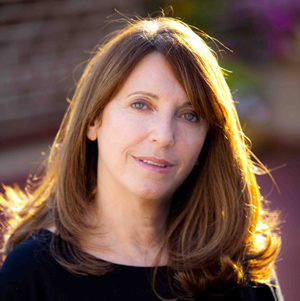
Filmmaker Gaylen Ross
Jan:
Okay, so, last question. What’s your own personal take away from all of this? What’s the most important thing you've learned through this 10-year process?
Gaylen:
I’m thinking: What’s next? Now we have my film about Kasztner; now there are several new books about Kasztner, much history and scholarship; so, what's next? When are the institutions and museums going to look at this story, and start to include it and talk about it instead of being embarrassed and ashamed?
There are Jewish film festivals in America that are reluctant to show my film. They don’t trust their audiences, and they don’t understand that their audiences want to see it. They’re nervous about it. It’s time to stop being nervous—not just about Kasztner, but about the entire subject of Jewish rescue. Why can’t we talk about Jewish rescuers during WWII?
We brought the film to Budapest and it was amazing—again, sold-out audiences, incredible conversations. I was with Zsuzsi (Kasztner’s daughter), and we were walking around the Jewish Quarter, and there’s this incredible
statue of Carl
Lutz. Lutz was not Jewish. He saved many Jews, and the statue shows Lutz as a sort of winged angel with his hand reaching down to the ground—and below Lutz, prone on the ground, with his hand reaching up, is the Jew. And this is how righteous gentiles are viewed—saving the victim, saving the helpless Jew.
Kasztner was not prone on the ground, nor is he ever going to be characterized as a winged angel. So where—between the victim and the savior—does Rezso Kasztner exist?
© Jan Lisa Huttner (12/15/09)
December 1 telephone interview conducted,
condensed & edited by Jan Lisa Huttner.
All photographs courtesy of Gaylen Ross.
